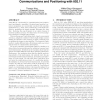97 search results - page 12 / 20 » Prediction and Adaptation in Active Harmony |
COGSCI
2011
13 years 2 months ago
2011
The psycholinguistic literature has identified two syntactic adaptation effects in language production: rapidly decaying short-term priming and long-lasting adaptation. To explai...
AROBOTS
1999
13 years 10 months ago
1999
We present a framework for constructing representations of space in an autonomous agent which does not obtain any direct information about its location. Instead the algorithm relie...
CAISE
2011
Springer
13 years 2 months ago
2011
Springer
Abstract. Flexibility and automatic learning are key aspects to support users in dynamic business environments such as value chains across SMEs or when organizing a large event. Pr...
CPHYSICS
2004
13 years 10 months ago
2004
We introduce here a new method for the numerical resolution of the Vlasov equation on a phase space grid using an adaptive semi-Lagrangian method. The adaptivity is obtained throu...
MOBISYS
2008
ACM
14 years 10 months ago
2008
ACM
Using 802.11 concurrently for communications and positioning is problematic, especially if location-based services (e.g., indoor navigation) are concurrently executed with real-ti...

